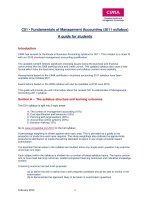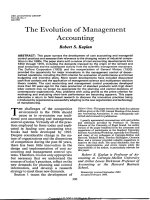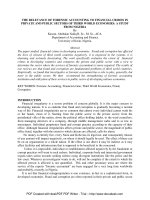Dictionary of 1000 Accounting Terms_8 pot
Bạn đang xem bản rút gọn của tài liệu. Xem và tải ngay bản đầy đủ của tài liệu tại đây (94.6 KB, 20 trang )
/>181
TAXABLE INCOME is that income that is reported to the government for the
purposes of calculating income taxes. Taxable income normally is not aligned
with the financial income reported within financial statements. See FINANCIAL
INCOME.
TAX EQUIVALENT YIELD is the yield that must be offered before factoring in
taxes so that an investment pays off a certain after-tax yield. This measure is
often necessary to compare taxable and tax-free investments, since tax-free
issues tend to have lower pre-tax yields due to the fact that the investment's
proceeds will not be reduced by taxes. Tax equivalent yield is equal to required
after-tax yield divided by (1 minus the tax rate).
TAX LOSS CARRY FORWARD/BACKWARD is a tax benefit that lets a
company or individual to deduct losses in order to reduce a tax liability.
TAX SHELTER are legal methods taxpayers can use to reduce tax liabilities. An
example is the use of depreciation of assets.
TERM BONDS are bonds whose principal is payable at maturity. Sometimes
referred to as bullet-maturity bonds or bullet bonds.
TERM DEBT, as in Term Bonds, is debt that mature in one lump sum at a
specified future date. Term debt is usually carried as one type of long-term debt.
TERM ENDOWMENT are endowments with time restrictions required by the
donor such as a restriction that the income from the endowment may not be
utilized until a future period or a specific date for condition is met.
TERMINAL VALUE, when used in a discounted cash flow valuation, the cash
flow is projected for each year into the future for a certain number of years, after
which unique annual cash flows cannot be forecasted with reasonable accuracy.
At that point, rather than attempting to forecast the varying cash flow for each
individual year, one uses a single value representing the discounted value of all
subsequent cash flows. This single value is referred to as the terminal
value.When a firm's cash flows grow at a "constant" rate forever, the present
value of those cash flows can be written as: Value = Expected Cash Flow Next
Period / (r - g)where, r = Discount rate (Cost of Equity or Cost of Capital) g =
Expected growth rate. This "constant" growth rate is called a stable growth rate
and cannot be higher than the growth rate of the economy in which the firm
operates. While companies can maintain high growth rates for extended periods,
they will all approach "stable growth" at some point in time. When they do
approach stable growth, the valuation formula above can be used to estimate the
"terminal value" of all cash flows beyond.
/>182
TERM LOAN is a bank loan, typically with a floating interest rate, for a specified
amount that matures in between one and ten years and requires a specified
repayment schedule.
TESTIMONY is evidence given by a competent witness under oath.
THIRD PARTY is someone other than the principals directly involved in a
transaction or agreement.
THIRD PARTY RECOVERY normally refers to delinquent accounts receivable
recovered by a collection agency for a fee.
THREE PERCENT (3%) RULE is a rule used in vesting pension plan benefits.
The participant's accrued benefit must be at least equal to 3% of the participant's
normal projected retirement benefit for each year of participation, with a
maximum of 100% after 33 1/3 years of participation.
TI is an acronym that could mean, among others, Total Income or Tenant
Improvements.
TILL ROLL is a roll of paper on which the separate amounts of money paid for
goods are recorded in a retail shop's cash register.
TIME LAG see LAG TIME.
TIME PERIOD CONCEPT provides that accounting take place over specific time
periods known as fiscal periods. These fiscal periods are of equal length, and are
used when measuring the financial progress of a business.
TIMES FIXED CHARGES EARNED see COVERAGE OF FIXED CHARGES.
TIMES INTEREST EARNED (TIE) measures the extent to which operating
income can decline before the firm is unable to meet its annual interest costs.
The TIE ratio is used by bankers to assess a firm’s ability to pay their liabilities.
TIE determines how many times during the year the company has earned the
annual interest costs associated with servicing its debt. Normally, a banker will
be looking for a TIE ratio to be 2.0 or greater, showing that a business is earning
the interest charges two or more times each year. A value of 1.0 or less suggests
that the firm is not earning sufficient amounts to cover interest charges.
TIME TO MARKET (TTM) is the length of time it takes to develop a new product
from an early initial idea for a new product to initial market sales. Precise
definitions of the start and end point vary from one company to another, and may
vary from one project to another within the company.
/>183
TIME VALUE OF MONEY is the idea that a dollar today is worth more than a
dollar in the future, because the dollar received today can earn interest up until
the time the future dollar is received.
TOBIN RATIO see MARKET TO BOOK VALUE.
TO DATE is prior to the current date.
TOP DOWN is a concept of analyzing a subject, such as costs or revenue,
starting from the highest level working towards the bottom.
TOP-LINE of a company is its gross sales, or revenue figure.
TOTAL ASSETS is the total of all assets; both current and fixed.
TOTAL ASSET TURNOVER measures management's efficiency in managing all
of a firm’s assets - specifically the generation of revenues from the firm's total
investments in assets. This ratio is extremely important in high asset firms such
as manufactures and telecommunications companies. Generally, the higher this
ratio as compared to like companies or the industry:
the smaller the investment required to generate sales, thus the more
profitable the firm.
indicates the firm has less money tied up in fixed assets for each dollar of
sales revenue.
TOTAL CURRENT ASSETS is total of cash & equivalents, trade receivables,
inventory and all other current assets.
TOTAL CURRENT LIABILITIES is the total of notes payable-short term, current
maturities-LTD, trade payables, income taxes payable, and all other current
liabilities.
TOTAL LIABILITIES & NET WORTH is the sum of all liability items and Net
Worth.
TOTAL QUALITY MANAGEMENT (TQM) is a structured system for satisfying
internal and external customers and suppliers by integrating the business
environment, continuous improvement, and breakthroughs with development,
improvement, and maintenance cycles while changing organizational culture.
TQM see TOTAL QUALITY MANAGEMENT.
TRACEABLE, in accounting, is to discover by going backward over the
transactions (evidence) step by step establishing a "paper-trail" for a transaction.
/>184
Non-traceable is where the "paper-trail" of a transaction is broken or non-
existent.
TRADE DISCOUNT is a producer discount given to retail trade members to
assist them in increasing sales of the producer's product.
TRADE DRAFT is a draft addressed to a commercial enterprise.
TRADE EXCHANGE is a barter system where people or companies trade goods
and services without the use of money. In the U.S., income from barter
transactions is considered taxable.
TRADE NAME is a distinctive name used to identify a product or company and
build recognition. Many corporations; e.g. Coca Cola, Ford, IBM, etc.;
aggressively protect their trade names within the market.
TRADE PAYABLE, also known as an account payable, is an amount owed to a
creditor for goods and services received.
TRADE RECEIVABLES (NET) are all accounts from trade, net of allowance for
doubtful accounts.
TRADING CONCERN is an entity that derives its products for sale, thereby
revenue, through purchasing products for sale from other producers /
manufacturers for resale to their customer base.
TRADING PROFIT is that profit earned from the short-term trading of securities
that were held for less than one year. Such profit is usually subject to tax at
regular income tax rates.
TRAILING, in time periods, is the most recently completed time period. For
example, trailing twelve months would be the twelve-month period which ended
on the final day of the last month.
TRANCHES are related securities that are offered at the same time but have
different risk, reward, and/or maturity.
TRANSACTION is an event or happening that changes financial position and/or
earnings.
TRANSACTION DRIVERS are used to count the frequency of an activity, i.e.,
the number of times an activity is performed.
TRANSACTION EXPOSURE, in foreign exchange, is the possibility of incurring
exchange gains or losses on transactions already entered into and denominated
/>185
in a foreign currency. It is typified by real exchange gains or losses and mixes
retrospective and prospective views. It is short-term in nature.
TRANSFER PRICE is the price charged by an individual entity in a multi-entity
corporation on transactions among the entities involved.
TRANSLATION EXPOSURE, in foreign exchange, is to convert the results of
foreign operations from the local currency to the home currency in the areas of
paper exchange gains or losses; it is retrospective and short-term in nature.
TRANSPARENCY, in economics, (1) Principle adopted in the General
Agreement on Tariffs and Trade that governments must make their rules,
regulations, and practices open and accessible to the public and other
governments. (2) General Agreement on Trade in Services requirement that its
member states publish their regulations affecting trade in services, that they
notify the Council for Trade in Services of any relevant changes, and that they
respond promptly to requests for information from other members.
TRANSPOSITION ERROR is the unintentional exchange of two elements of an
ordered list with all others staying the same. A transposition is therefore a
permutation of two elements. For example, the swapping of 2 and 5 to take the
list 123456 to 153426 is a transposition. In this example, if the newly ordered list
of 153426 was unintentional, it would be commonly called a transposition error.
In accounting, an error in copying a number from one place to another is a
transposition error.
TREASURY CERTIFICATE is a U. S. Treasury security usually issued at par
with a specified rate of interest and a maturity of one year or less. It is issued
payable to the bearer and sold in minimum amounts of $l0,000.
TREASURY STOCK is stock reacquired by the issuing company and available
for retirement or resale. It is issued but not outstanding. It cannot be voted and it
pays or accrues no dividends. It is not included in any of the ratios measuring
values per common share.
TREND ANALYSIS is the analysis of changes over time through the use of
analytical techniques, such as time series analysis, to discern trends.
TRIAL BALANCE is a listing of the accounts in your general ledger and their
balances as of a specified date. A trial balance is usually prepared at the end of
an accounting period and is used to see if additional adjustments are required to
any of the balances. Since the basic accounting system relies on double-entry
bookkeeping, a trial balance will have the same total debit amount as it has total
credit amounts.
/>186
TRIPLE BOTTOM LINE (TBL) is a metric for a corporation's social,
environmental, and economic performance. TBL is the latest series of buzz
words to describe business involvement in sustainability. TBL is all about
dropping the financial bottom line as a meaningful indicator of where you stand in
the market place and replacing it with a bottom line that properly acknowledges
the interplay of the social economic and environmental dimensions of our lives.
TRIPLE NET LEASE is a real property lease that requires the tenant to pay for
all maintenance expenses, utilities, taxes, and insurance. Usually done under a
limited partnership, resulting in lower risk for investors.
TRIPLE P is a productivity model wherein the interrelationship between
productivity, profitability and performance, as well as, effectiveness and efficiency
are plotted in a schematic view where the main difference between these five
terms can be captured.
TRUE AND FAIR VIEW is one of the most prominent principles of accounting. It
suggests that an enterprise should provide a true and fair view about its financial
conditions and operating results. The concept of true and fair view does not
mean absolute truth about enterprises. Financial statements are a product of
management's judgments and estimates. The principle of true and fair view
requires comparative truth about the enterprises' picture. True and fair view is
rather defined operationally; it is thought to be accomplished by complying with
all other lower accounting principles.
TRUE VALUE is the amount that a buyer is finally willing to pay.
TRUST ACCOUNT is a separate bank account, segregated from a broker's own
funds, in which the broker is required by state law to deposit all monies collected
for clients; in some states called an ESCROW ACCOUNT.
TRUST DEED is an instrument of conveyance of title to property wherein the
transferee will be holding the title to the property on behalf of another person.
TRUST FUND is a fiduciary relationship calling for a trustee to hold the title to
assets, usually monetary, for the benefit of the beneficiary.
T/T is a payment or financial transaction designation meaning "Telegraphic
Transfer" of funds.
TTM see Time To Market.
TURNOVER, in U.S. accounting, is the number of times an asset is replaced
during a financial period; often used in terms of inventory turnover or accounts
receivable turnover. In securities, for either a portfolio or exchange, TURNOVER
/>187
is the number of shares traded for a period as a percentage of the total shares. In
Great Britain, TURNOVER means sales.
TWO PARTY ENDORSEMENT, normally, is when two signatures are required to
make a document or bank draft legal or authorized.
/>188
ULLAGE is the empty space present when a shipping container is not full.
UNALLOCATED COSTS represents corporate costs not associated either
directly or indirectly in providing a product or service for sale. Unallocated costs
are not included in the calculation of COST OF GOODS SOLD.
UNAUDITED OPINION is a qualified opinion by a Certified Public Accountant
who has not audited the relevant financial statements.
UNBUDGETED are items and/or amounts that are currently not included within a
budget.
UNCONTROLLABLE EXPENSE is expense that cannot be controlled or
restrained. Some of the costs of doing business can not be postponed or spread
out over a longer period of time (e.g., taxes, rent and utilities).
UNDERBUDGETED is a line item within a budget to where the budgeted amount
is not sufficient to cover the actual amount.
UNDERLYING is the security, cash commodity, forward, futures contract, swap,
or other contract or instrument that is the subject of a derivative contract or
instrument.
UNDERRECORDED normally refers to an understatement as to what a total
would be if all data was accurately included or considered; e.g. underrecorded
costs, revenues, population, etc.
UNDERSTATED is to represent as less than is the case.
UNEXPIRED means not having come to an end or been terminated by the
passage of time.
UNDISTRIBUTED EARNINGS see Retained Earnings.
UNEARNED REVENUE / INCOME represents money that you have received in
advance of providing the goods or services to your customer. Unearned revenue
is a liability of your business until you provide the goods or services you agreed
to provide to the customer.
UNICAP see UNIFORM CAPITALIZATION RULES.
UNIFORM CAPITALIZATION RULES (UNICAP), in the U.S., is a method of
valuing inventory for tax purposes that requires capitalization of direct costs, e.g.
material and labor, and an allocable portion of indirect costs that benefit or are
incurred because of production or resale activities. Certain expenses must be
included in the basis of the property or in inventory costs rather than currently
/>189
deducted. These costs are then recovered through depreciation or amortization
or as cost of goods sold.
UNIT-CONTROL SYSTEM is an accounting system used in inventory
management that tracks inventory using bin tickets and physical inventory
checks.
UNIT COST see OBJECT COST.
UNIT-LEVEL ACTIVITY, in Activity Based Costing, is an activity that must be
done for each unit of production.
UNREALIZED INCOME (paper profit) is profit which has been made but not yet
realized or collected through a transaction, such as a stock which has risen in
value but is still being held. also called unrealized gain or unrealized profit or
paper gain or book profit.
UNREALIZED LOSS is a term that commonly refers to the write-down of an
investment portfolio resulting from applying the lower of cost or market value on
an aggregate basis. On a short-term portfolio, the unrealized loss is shown on
the income statement. On a long-term portfolio, the unrealized loss is presented
as a separate item in the stockholder's equity section of the balance sheet.
UNRESTRICTED ASSETS are assets / resources which are not restricted for
use by legal or contractual requirements and may be used for any purpose.
UNSECURED is obligation backed not by collateral but only by the integrity of
the borrower. Opposite of secured.
UPSTREAM / DOWNSTREAM SALES is normally associated with inter-
company sales: Upstream is a subsidiary selling into the parent entity; while
downstream is the parent selling into a subsidiary.
UNUSUAL GAINS AND LOSSES are material gains and losses that are either
unusual or occur infrequently, but not both, are excluded from the extraordinary
item classification (see EXTRAORDINARY ITEMS).
USEFUL LIFE is the expected period of time, in years, during which a
depreciating asset will be productive.
/>190
VAD, in business, can mean: Value of Annual Demand, Value-Added Data,
Value-Added Dealer, or, Value-Added Distributor.
VALIDATE is to a. declare or make legally valid; b. mark with an indication of
official sanction; or, c. to establish the soundness of; corroborate.
VALUATION ALLOWANCE/RESERVE is an allowance to provide for changes
in the value of a company's assets, such as depreciation or if an asset is deemed
impaired.
VALUE is a term that defines the worth of a thing. The term is usually preceded
by the word, or words such as 'Fair" or "Fair Market", and it is usually defined in
the document where it is found. Not all value for an item is the same, i.e. value is
usually perceived.
VALUE ADDED is the difference, at each stage of production or the provisioning
of a service, between the price of a product or service and all materials or
activities paid for to produce the product or provide the service.
VALUE ADDED TAX is a consumption tax where taxes are levied at each step
of a manufacturing process where value is added to that product at that point in
the manufacturing cycle; as well as at the point where the consumer purchases
the end product.
VALUE ADDED VERTICAL INTEGRATION is controlling as much of the build
stream, both upstream and downstream, in producing a product or service as
possible while ensuring that every part of the stream provides added value. See
also VALUE ADDED and VERTICAL INTEGRATION.
VALUE CHAIN is the sequential set of primary and support activities that an
enterprise performs to turn inputs into value-added outputs for its external
customers. As developed by Michael E. Porter, it is a connected series of
organizations, resources, and knowledge streams involved in the creation and
delivery of value to end customers. Value systems integrate supply chain
activities, from determination of customer needs through product/service
development, production/operations and distribution, including (as appropriate)
first-, second-, and third-tier suppliers. The objective of value systems is to
position organizations in the supply chain to achieve the highest levels of
customer satisfaction and value while effectively exploiting the competencies of
all organizations in the supply chain.
VALUE FOR MONEY is in the perception of the buyer or receiver of goods
and/or services. Proof of good value for money is in believing or concluding that
the goods/services received was worth the price paid. Examples of the types of
factors that may be considered are suitability, quality, skills, price, whole of life
/>191
costs and other criteria. The mix of these and other factors and the relevant
importance of each will vary on a case by case basis.
VALUE IN USE is the value of an asset in the opinion of the owner.
VALUE MANAGEMENT is the application of established techniques to help
define and refine business need, delivery strategy and the best value concept by
setting customer objectives and values and determining success criteria for the
project.
VAR is an acronym for Value-Added Reseller (usually of technology products);
or, in finance, Value at Risk.
VARIABLE COSTS are those costs associated with production that changes
directly with the amount of production, e.g.,the direct material or labor required to
complete the build or manufacturing of a product.
VARIANCE ANALYSIS is the analysis of performance by means of variances.
Used to promote management action at the earliest possible stages. After a
budget (based on standard costs) has been set, its usefulness lies in the review
procedures which compare actual results against the budget. Variance analysis
is the process of examining in detail each variance between actual and
budgeted/expected/standard costs to determine the reasons why budgeted
results were not met (material costs too high, sales prices too low, etc.).
VARIABLE EXPENSES are those business expenses that usually fluctuate
dependent upon production or sales volume. Contrast with FIXED EXPENSES.
VARIANCE, in accounting, is the difference between a projected number and the
actual number, e.g. 1. a budget variance is spending either more or less from the
amount that was budgeted; and 2. a cost variance is the difference between
actual cost and standard cost in the categories of direct material, direct labor,
and direct overhead.
VAT see VALUE ADDED TAX.
VENDOR MANAGED INVENTORY (VMI) is a process in which a supplier
generates orders for its distributor based on demand information sent by the
distributor. Vendor Managed Inventory was first applied to the grocery industry,
between companies like Procter & Gamble (supplier) and Wal-Mart (distributor).
But increasingly, Vendor Managed Inventory is providing the benefits of
smoother demand, increased sales, lower inventories and reduced costs to other
industries.
/>192
VENDOR STATEMENT is a statement by the seller to the buyer detailing
material particulars regarding the property in question (suitability for intended
use).
VENTURE CAPITAL is capital committed to an unproven venture. The initial,
start-up money is referred to as "seed money" and entails the greatest risk. If the
project gets off the ground it may require additional financing at additional
"rounds" or the "mezzanine level" before the company is finally brought to the
market and the venture capitalist can enjoy handsome rewards. Experienced
investors in venture capital situations typically plan on turning away a minimum of
9 out of every 10 proposals which are brought to them, and then they expect as
many failures as successes from their selected investments.
VERIFIABILITY is where the fact is capable of being tested (verified or falsified)
by experiment or observation.
VERTICAL FINANCIAL ANALYSIS allows comparison of the financial ratios of a
company in time – past, present and future.
VERTICAL INTEGRATION is the extent to which a firm owns its upstream
suppliers and its downstream buyers. Control upstream is referred to as
backward integration (towards suppliers of raw material), while control of
activities downstream (towards the eventual buyer) is referred to as forward
integration.
VESTED refers to having an absolute right or title, when previously the holder of
the right or title only had an expectation. Example: after 20 years of employment
Larry Loyal's pension rights are now vested.
VIABILITY, in economics, is the capability of developing and surviving as a
relatively independent social, economic or political unit.
VMI see VENDOR MANAGED INVENTORY.
VOLUME GAIN is to obtain advantages due to increase in volume, such as value
increase, points in gross margin or profit.
VOSTRO ACCOUNT is a local currency account maintained with a bank by
another bank. The term is normally applied to the counterparty's account from
which funds may be paid into or withdrawn, as a result of a transaction.
VOUCHER is a. a piece of substantiating evidence; a proof; or, b. a written
record of expenditure, disbursement, or completed transaction; or, c. a written
authorization or certificate, especially one exchangeable for cash or representing
a credit against future expenditures.
/>193
WACC see Weighted Average Cost of Capital.
WAGE is actual remuneration paid to an employee for services rendered.
Minimum wages, in the U.S.A., are established by the federal Fair Labor
Standards Act.
WARRANT, in government accounting, is an order drawn authorizing payment to
a designated payee. In securities, it is a security entitling the holder to buy a
proportionate amount of stock at some specified future date at a specified price,
usually one higher than current market. This "warrant" is then traded as a
security, the price of which reflects the value of the underlying stock. Warrants
are issued by corporations and often used as a "sweetener" bundled with another
class of security to enhance the marketability of the latter. Warrants are like call
options, but with much longer time spans sometimes years. In addition,
warrants are offered by corporations whereas exchange traded call options are
not issued by firms.
WARRANTY is a guarantee given to a buyer from a seller that the goods or
services purchased will perform as promised, or a refund will be given, repair will
be done at no charge, or an exchange made.
WEIGHTED AVERAGE is one in which different data in the data set are given
different "weights." Varying subjective assumptions are derived for determining
the level of importance for each data category. For example, many teachers will
use a "weighted average" when calculating a student's grade in a course. A
teacher might determine the final grade for the course by calculating that the test
average is 60% of the grade, quiz average is 30% of the grade, and a single
project is 10% of the grade.
WEIGHTED AVERAGE COST OF CAPITAL (WACC) is an average
representing the expected return on all of a company's securities. Each source of
capital, such as stocks, bonds, and other debt, is weighted in the calculation
according to its prominence in the company's capital structure.
WHITE PAPER 1. in a technological industry, is an informational brief offering an
overview of a technology, product, issue, standard, policy, or solution - its
importance, use and implementation, and business benefits. White Papers have
emerged as the standard way of communicating more in-depth information to
business decision-makers in terms of problems solved and markets addressed;
or, 2. a White Paper can be an official government report of an investigation into
a public event that received a great deal of publicity and notoriety; it indicates the
official government position on a particular public issue.
WHOLLY OWNED SUBSIDIARY is an entity whose parent owns virtually 100%
of its common stock.
/>194
WINDFALL PROFIT/GAIN is profit that occurs suddenly as a result of an event
not controlled by the company or person realizing the gain from the event. For
example, a hurricane may bring extraordinary revenue to a roofing contractor as
a result of the natural disaster.
WINDOW DRESSING is the act or an instance of making something appear
deceptively attractive or favorable. Usually using something, e.g. inflated sales
projections, to create a deceptively favorable or attractive impression.
WINDOW OF ENTERPRISE depicts the overall structure of accounting.
WIDGET is a device that is very useful for a particular job. Often used within a
name of a fictitious company.
WIP is an acronym for Work in Process/Progress. Usually refers to inventory that
has value added from labor or additional processing. When considered for
inventory value, the value of the raw material plus the value added component is
accounted for in determining the value of that inventory at that point in the
process.
WITHHOLDING TAX usually refers to those taxes that are withheld from an
employee’s compensation to account for that individuals tax liability on his/her
compensation.
WITNESS is an individual who testifies at a trial on what he has seen, heard, or
otherwise observed.
WORK CENTER, normally, is an individual production area or sub-process of an
overall manufacturing process.
WORKER’S COMPENSATION is, usually, a state or privately managed
insurance fund in the United States that reimburses employees for injuries
suffered on the job.
WORKING CAPITAL STATEMENT (WCS) is part of the financial statements'
"Statements of Cash Flows or Changes in Financial Position." The WCS normally
includes sections covering: Sources of Working Capital, Uses of Working Capital,
and Working Capital Changes.
WORKING CAPITAL TURNOVER (WCT) shows how efficiently Working Capital
(WC) is employed, i.e., it measures how efficiently the business is using its
available assets. WCT measures the amount of Net Revenue generated per
monetary unit of Working Capital. It varies widely by industry; therefore it is best
to compare WCT to industry averages.
/>195
WORKING CAPITAL (WC) (the difference between current assets and current
liabilities) measures the margin of protection for current creditors. It reflects the
ability to finance current operations.
WORK IN PROCESS is parts and subassemblies in the process of becoming
completed finished goods.
WORK IN PROGRESS a piece of work that is not yet finished.
WORK SHEET is a document or schedule in which an accountant or auditor
gathers information to substantiate an opinion concerning an account balance or
'test of transaction.'
WORLD TRADE ORGANIZATION (WTO) is the international trade body formed
by the agreement of member nations. The WTO is an evolution of the GATT
process designed to resolve trade disputes and work for the lowering of tariff and
non-tariff trade barriers.
WRAP ACCOUNT at its most basic is an alternative form of commission
arrangement between a securities firm and its client. Wrap accounts generally
charge the client an annual fee based on assets in the account in lieu of a per
transaction commission structure. In other words, the firm "wraps" together all the
costs and charges them off as a "management fee”. Firms often add further
features to wrap accounts such as investment management, custodial services,
and enhanced reporting.
WRITE-OFF is to decrease the value of an item, e.g., a tax write-off decreases
tax liability, a vehicle involved in an accident can be declared a write-off if the
cost to repair is in excess of the value of the vehicle.
WRITE-UP is the increase in value of an asset, but it is seldom used and is not
allowed in GAAP (Generally Accepted Accounting Principles).
WRITE-UP SERVICE is the provisioning of all reporting requirements of
bookkeeping and accounting services. The following is a non-exhaustive list of
reporting services provided:
1099s report preparation for subcontractors.
Bank account reconciliation.
Check coding.
Fixed asset schedules.
Maintenance of general ledger.
Payroll deposit calculations.
Payroll tax filings.
Personal property tax returns.
Preparation of internal financial statements.
/>196
/>197
X-INEFFICIENCY is the failure to minimize costs or maximize returns.
(Sometimes referred to as X-efficiency, but carrying the same meaning.)
/>198
YANKEE BOND is a dollar bond issued by a non-U.S. borrower in the United
States.
YEN is the currency of Japan. Its subdivisions are 100 sen and 1000 rin.
YIELD is the annual return on an investment, expressed as a percentage. The
yield to redemption or maturity (the same thing) combines the running yield with
the "pull to redemption"; thus a bond which has a 10% coupon and exactly one
year of remaining life will sell at $98.2% when interest rates are at 12.0%, that
12.0% being composed of 10.2% running yield and 1.8% pull to redemption
($100.0 - 98.2%).
/>199
ZERO BASED BUDGET is where the expenses or costs of the prior year are not
taken into consideration when establishing expense or budgetary levels looking
forward. Each expense category starts from zero. All expenses or cost levels
within the budget must be justified or re-justified as being necessary; thus “zero-
base”.
ZERO COUPON BONDS are bonds priced at a large discount from face value.
The bonds mature at full face value so the difference between the original issue
price and the face value represents interest income. The issuer of the zero
coupon bond saves on cash flow since the interest isn't paid out until the end of
the bond holding period.
ZERO COUPON CONVERTIBLE DEBENTURE/SECURITY is a zero coupon
bond that is convertible into the common stock of the issuing company after the
common stock reaches a certain price.
Z-SCORE see ALTMAN'S "Z-SCORE"
/>200
3% RULE see THREE PERCENT RULE.
4-4-5 CALENDAR, in budgeting and accounting, is the breakdown of each
month into weeks by counting the number of times Friday occurs within each
month, e.g., Jan = 4 weeks, Feb = 4 weeks, Mar = 5 weeks, Apr = 4 weeks, May
= 4 weeks, Jun = 5 weeks… etc. to total 52 weeks in a 12 month period. Every
third month, Friday will occur 5 times. All other months, Friday will occur 4 times.
In the months where Friday occurs 5 times, it is considered a 5 week month.
Whereas, the 4 Friday months will be considered as 4 week months.
10-K is the audited annual report that most reporting companies file with the
Securities Exchange Commission (SEC). It provides a comprehensive overview
of the registrant's business. The report must be filed within 90 days after the end
of the company's fiscal year.
10-Q is a report filed quarterly to the Securities Exchange Commission (SEC) by
most reporting companies. It includes unaudited financial statements and
provides a continuing view of the company's financial position during the year.
The report must be filed for each of the first three fiscal quarters of the company's
fiscal year and is due within 45 days of the close of the quarter.
13TH PERIOD in the fiscal year is the period used for fiscal year-end adjusting
entries (periods 1-12 being the months in the fiscal year).
80 - 20 RULE (Pareto Principle/Law) is a general rule of thumb in business that
says that 20% of the items produce 80% of the activity, while 20% of the product
line produces 80% of the sales, 20 % of the customers generate 80% of the
complaints, and so on. In evaluating any business situation, look for the small
group which produces the major portion of the transactions you are concerned
with. This rule is not exactly accurate, but it reflects a general truth, nothing is
evenly distributed.
401 (K) PLAN is a retirement plan in the United States that allows qualified
employees to contribute money from their paychecks into a tax-sheltered
account.
940 Form is the U.S. IRS Employer's Annual Payroll Tax form.
941 Form is the U.S. IRS Employer's Federal Quarterly Payroll Tax form.









